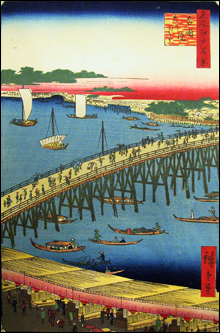
QUIET ACTIVITY: "Ryogoku Bridge and the
Great Riverbank" by Hiroshige. |
There’s a small jewel of a show nestled into a side gallery of the Bowdoin College Museum of Art in Brunswick. It’s filled with Japanese prints that arrest and hold the viewer’s attention as surely as any works of art from any period or any culture.
These are ukiyo-e woodblock prints, pictures of the "floating world" that were mostly made between the late 17th and early 20th centuries. The prints were made for the popular market and were affordable enough for successful townsmen of the Edo and early Meiji periods. The floating world was the subculture of brothels and entertainment palaces, and the subjects were often courtesans and, as the craft developed, landscapes and depictions of sumo wrestlers and kabuki actors.

Pictures of courtesans and their entertainments were sometimes used as a catalog from which the client could anticipate the character of his upcoming diversion. In "Courtesans in a Brothel" by Yoshiiku, from about 1870, a group of women in elaborately-patterned dress sit so closely to one another that their costumes nearly blend together. Above and behind them the edge of a roof surrounding a courtyard extends at a sharp angle down toward the right side of the picture, anchoring the visually busy group while indicating these artists had learned perspective from Western art.
| "Japanese Prints" | through June 22 | at Bowdoin College Museum of Art, Brunswick | 207.725.3275 |
Influences went both ways. Ukiyo-e prints found their way to the West in the 19th century and were looked at carefully by the European avant-garde. The patterns on the dress of the Yoshiiku courtesans make a jumble of intermingled colors, each laid in the distinct divisions necessitated by the woodblock process, yet the overall sense of that busy area is one of order and harmony. It was a lesson not lost on the Cubists nor, for that matter, the Abstract Expressionists.The centerpiece of the show is a scroll of some 80 of Hiroshige’s classic “Hundred Famous Views of Edo.” These prints were made toward the end of Hiroshige’s life, between 1856 and 1859. The last few were issued after the artist’s death in a cholera epidemic in 1858. Hiroshige had never been financially successful in his lifetime, which no doubt drove his prolific output. The “Hundred Views” had been paid for up-front. Nowadays he is reckoned one of the greatest of the ukiyo-e artists. Van Gogh copied at least two of the “Views” directly.
The pigments used in these prints are subject to fading in direct light, so the museum will be unrolling the scroll over the course of the show. A different half-dozen or so of the prints will be visible each week. According to curatorial assistant Kacy Karlen, who selected the show from the museum’s permanent collection, the scroll was an unusual way for these prints to be collected. The museum staff will be lifting the prints from the scroll after the show so they can be stored and eventually exhibited individually.
In “Ryogoku Bridge and the Great Riverbank” Hiroshige organized the picture in a dynamic Z-shape, with shopping stalls on the near bank forming the lower leg, the slightly curved bridge making a diagonal to the upper right, and the far bank coming back across near the top. There are dozens of little figures walking among the stalls and across the bridge. His sure hand has made these figures entirely convincing, even while close examination shows each of them is made with only a few lines. Boatmen move people or cargo up and down the river using stern-mounted single sweeps. Above the bridge there are a few boats under sail. There is plenty of activity but everything seems very still.
Hiroshige used some special printing techniques to introduce gradations of color into the work. The blue water of the river gets darker in the shadow of the bridge and along the banks. The red land of the far bank grows lighter as it approaches the horizon. The effect is subtle and convincing.
As these works were finished Hiroshige "retired from the world" and became a Buddhist monk. There is a powerful sense of calm and focus in them, and it makes them a joy to visit.
Ken Greenleaf can be reached at ken.greenleaf@gmail.com.